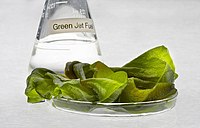
Photo from wikipedia
Abstract Establishing marine species equipped with efficient biomarkers of trace element stress is a major requirement for the assessment of trace element contamination in marine ecosystems. This study investigates PS… Click to show full abstract
Abstract Establishing marine species equipped with efficient biomarkers of trace element stress is a major requirement for the assessment of trace element contamination in marine ecosystems. This study investigates PS II overall activity and efficiency during light harvesting, electron transport chain (ETC) behaviour, OJIP-transient light curves, and pigment profiles, in the model marine diatom species Phaeodactylum tricornutum exposed to Cr, Co, Ni, Cu, Zn, Cd, Hg, Pb and to a mixture of all elements combined (Mix). OJIP-test parameters and trace element substituted chlorophylls were investigated as potential biomarkers of stress induced by trace elements. Hg-exposed cells showed a shift in balance towards PS I activity, promoted by increase in the electron transport from PQH2 to the reduction of PS I end electron acceptors. Other elements had more limited effects, mostly affecting energy dissipation and pigment levels to various degrees. Decoupling of PS II antennae connectivity was found in Co exposed cells. Chromium induced negative effects on PS I, but had no influence at the Oxygen Evolving Complexes (OECs) level. Copper caused a shift in the equilibrium between PS towards the PS I by reducing the PS II efficiency. Cadmium induced damage in OECs of the PS II donor side, but had no effect on the energy transduction pathway, maintaining energy processing efficiency. Lead had no significant effect on the energy transduction pathway, but produced changes at pigment level, leading to an increase in the chlorophyll and diadinoxanthin. In contrast, Ni had a beneficial role in P. tricornutum photochemistry, leading to increased number of available RC and oxidized quinone pool size, possibly because concentrations used were not able to induce severe cell damage. Copper, Cd and Zn led to substitution of Mg in chlorophyll a molecules, with the formation of less efficient CuChl a, CdChl a and ZnChl a. The biomarkers used evidenced the damaging effect of Co, Cu, Cr, Pb, Hg and all trace elements combined (Mix), pointing to Hg as the most harmful element. These physiological changes highlight P. tricornutum as a promising sentinel species for trace element contamination and the proposed photochemical features suitable as an efficient battery of biomarkers for trace element stress early detection in marine systems.
Journal Title: Ecological Indicators
Year Published: 2018
Link to full text (if available)
Share on Social Media: Sign Up to like & get
recommendations!